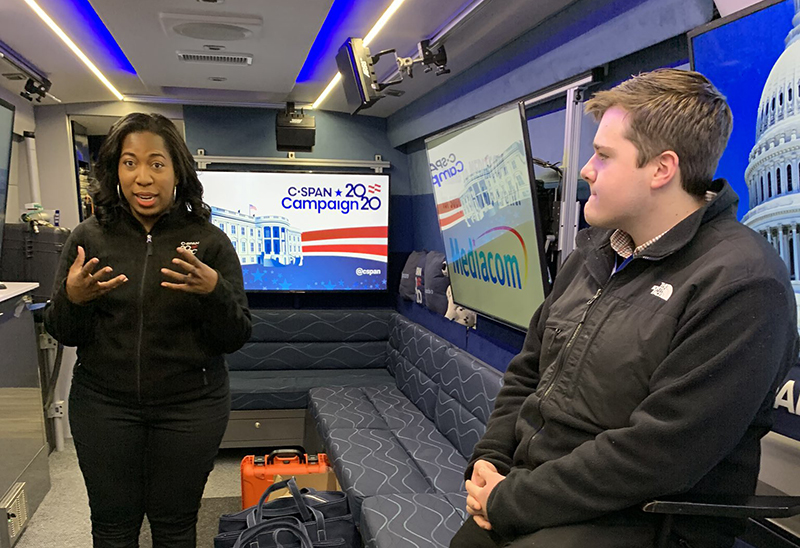Front-row seat in Iowa
C-SPAN giving student interns an up-close view of Iowa caucus process

When Brian Lamb first placed a C-SPAN camera inside an Iowa caucus location, many Americans – including some Iowans – had no clue how the process actually worked.
The public affairs cable network Lamb founded has televised the Iowa caucuses each presidential election year since that 1984 debut, but intrigue still surrounds this chaotic method of selecting a presidential candidate. It’s something you simply have to see to believe.
“People take it for granted today, but back then there were people that lived in Des Moines that had never seen a caucus, and they looked up at their television set and saw how it operated,” said Lamb, the 1963 Purdue alumnus for whom the School of Communication is named. “It’s clumsy. It’s not a neat little package. It doesn’t necessarily determine who’s going to be president, but it’s the beginning of the process, and that’s important.”
Over the next six days, C-SPAN will provide five Purdue undergraduates with a learning opportunity more meaningful than simply observing the process on television. They will actively participate in broadcasting what happens on the ground in Iowa.
The students will work as C-SPAN interns in Iowa leading up to Monday’s Democratic caucuses that will officially kick off the race for the party’s 2020 presidential nomination.
“One day they might be out at a [Pete] Buttigieg event that C-SPAN is covering, and then the next day they might be greeting guests for the morning show, "Washington Journal." It’s an experiential thing that C-SPAN has been so great to allow these students to come in and literally be part of the team,” said Center for C-SPAN Scholarship & Engagement managing director Connie Doebele, who organized and will chaperone the trip along with Diana Zulli, an assistant professor in the Lamb School.
It will be a whirlwind trip, for sure. The group departed Thursday morning on a six-hour drive to Des Moines, where a rented house will serve as home base for the next five nights. The students do not yet know where they will work on any given day – only that they will be able to observe at least one caucus session on Monday.
“Every night the routine will be that we receive plans for the next morning,” said participant Andie Slomka, a sophomore studying political science and genetics. “That can be anywhere from late afternoon to really late at night when we get those plans for where everybody’s going. And then it’s really going to vary day by day for each student.”
undefined
Slomka is a walking billboard for the wealth of educational opportunities that the C-SPAN Center provides the Purdue community. She interned with the Center last fall, won its undergraduate research competition, participated in its Maymester program in Washington, D.C., and is currently a student in the course Lamb and Doebele are co-teaching on presidential communication in an election year.
She expects the Iowa trip to provide a once-in-a-lifetime chance to observe the often-unruly caucus process, where participants go to great lengths to convince other caucus-goers to support their chosen candidates.
“I’ve learned about caucuses and primaries for years throughout school. You can only learn so much in the classroom. Going to it and actually experiencing it is a whole different ballgame,” said Slomka, who will join fellow undergraduates Ray Couture, Gerardo Pons de la Garza, Alyson DeHaai, and Kyle Foley on the trip. “You gain so much more knowledge that way. It’s almost like going to the zoo: You get to see the animal in person. We’ll get to see this gigantic political animal in person.”
A 2016 Christian Science Monitor story argued that the most relevant aspect of Iowa’s voting results will not be who wins, but instead who falls well short of expectations. Iowa’s outcome often helps narrow the field of candidates, and that narrowing could happen quickly this year since the Democratic field is unusually large. Fringe candidates who expend significant resources in Iowa and fail to generate momentum there may not remain in the race much longer.
As Lamb mentioned, however, the results from Iowa are not necessarily predictive historically. For instance, the state’s Republican winners over the last three elections were Mike Huckabee (2008), Rick Santorum (2012), and Ted Cruz (2016) – none of whom secured the nomination. The eventual Democratic nominee won in Iowa in each of the last six presidential elections, but the state’s caucus-goers have traditionally been unreliable predictors of that party’s nominee, as well.
“It’s still important for people to go out and see what it looks like on the ground,” Lamb said. “It’ll be cold, people will be everywhere from a high school gymnasium to somebody’s living room, and it’s the best of democracy.”